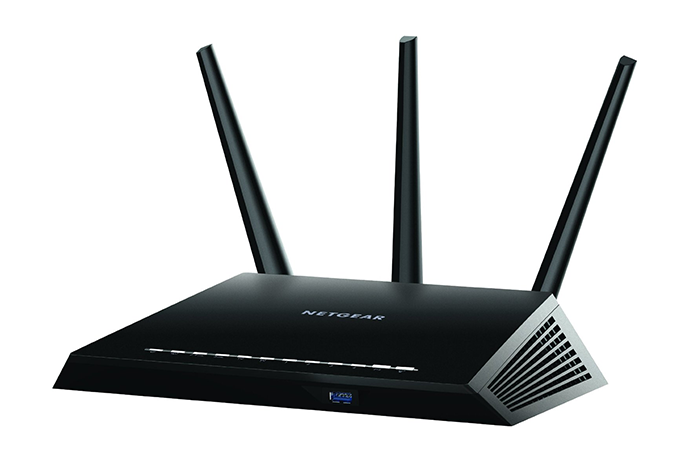Tom's Guide Verdict
The Netgear R7000 combines excellent 5-GHz speed with Netgear's handy Genie software, but this router doesn't have the best range.
Pros
- +
Excellent combined throughput
- +
Genie software
- +
Removable antennas
- +
Affordable
- +
Open-source firmware
Cons
- -
Disappointing range
- -
Large in-wall AC adapter
Why you can trust Tom's Guide
Editor's Note: As of Dec. 19, 2016, Netgear has issued security updates to patch a serious vulnerability in its routers, including the Nighthawk AC 1900. We recommend not using the Nighthawk AC 1900 until the update is applied, so click here to find out how to install the patch.
Netgear's Nighthawk AC 1900 Smart WiFi Router, better known as the R7000, is for those who need to save a few bucks while creating an up-to-date wireless network. At $190, it's priced about $100 less than the competition (including Netgear's own R8000) and delivers strong throughput, but can't match the range of other 802.11ac routers.
Design
At 11.2 x 7.3 x 2.0 inches, the black, angled Netgear R7000 looks like a smaller version of the company's R8000. Three finlike antennas attached to the back use beam-forming technology to optimize the signal. They can be aimed to grab the strongest signal or unscrewed and replaced with third-party options.
The R7000 can be wall-mounted or can sit on a shelf. Unfortunately, its in-wall AC adapter, at 3.5 x 2.8 x 1.1-inches, is awkwardly large and more than twice the size of the Trendnet TEW-812DRU's power plug.
Along its front edge, the R7000 has a dozen status LEDs. Lights indicate when it is turned on, is connected to the Web and has activity on its two bands. In addition, there are lights showing whether its Ethernet ports are active, the Wi-Fi Protected Setup (WPS) and whether Wi-Fi transmissions are turned on.
Unlike the more expensive Netgear R8000, there's no physical switch in the back to turn the lights off, but you can do so from the system's software. However, the R7000 does have switches for power, activating WPS and disabling its Wi-Fi transmissions. There's also a recessed reset button for wiping the firmware settings and starting over.
The back of the R7000 has 4-gigabit Ethernet ports, but lacks the teamed higher-speed ports that the ASUS RT-AC87U has. There's a USB 2.0 port in the back, as well as a USB 3.0 connection in the front for hard drives, memory keys and printers. But the R7000 does without the Linksys WRT 1900AC's eSATA port for directly plugging in a hard drive.
Get instant access to breaking news, the hottest reviews, great deals and helpful tips.
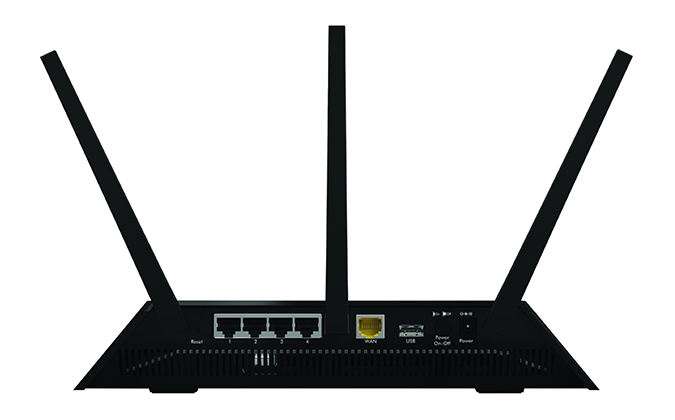
Rather than a tri-band design, the R7000 uses a 3x3 dual-band approach with 2.4- and 5-GHz transmitters. It adds up to a theoretical bandwidth of 1.9 Gbps. Recently, Netgear added the 4x4-based R7500 model, which hits a peak at 2.3 Gbps, but costs $100 more.
Setup
The Netgear R7000 comes ready to roll with a network cable, AC adapter and startup booklet. There's no CD with the manual or software, so you'll need to download them yourself.
All told, it took about five minutes to create a Wi-Fi network around the R7000. After plugging the router in and typing in its IP address (192.168.1.1) or "routerlogin.net," Netgear's intuitive Genie software pops up to set the system up. Alternately, you can manually configure the R7000. At the end of the configuration process, the R7000 provides a summary page of all the settings and passwords.
The R7000 arrived with unique network names and passcodes, which are printed on a label underneath the router; they should still be changed quickly. The router can work with everything from WEP to WPA2 encryption techniques, has Network Address Translation (NAT) and Stateful Packet Inspection (SPI) firewalls, and can protect against a Denial of Service attack.
MORE: Best Streaming Players
Able to run as a router, access point or a wireless bridge to push a Wi-Fi network into an uncovered part of the home, the R7000 is versatile. It can work with PC-based or Time-Machine-based Mac backups, set up an FTP site for remote access and operate as a DLNA and iTunes media server.
I was able to connect a variety of Android, iOS and PC clients to the R7000 manually or using its WPS system. On the downside, the system can use neither a Radius nor a LDAP server for authenticating potential clients. However, the system can set up a protective guest network that allows Internet access but can block use of the network's drives.
Genie Software
As is the case with the R8000, the R7000's Genie software has apps for PCs, Macs, iOS and Android devices. On the other hand, you can tap into the system's settings by pointing a Web browser window at the router's home address.
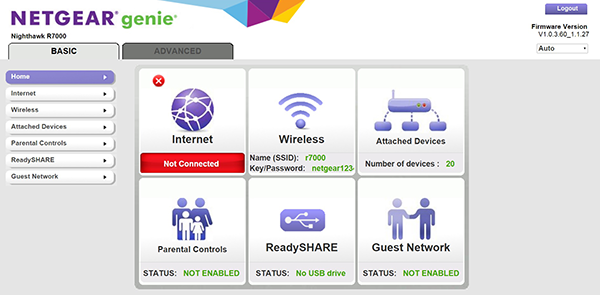
Genie's main screen provides a nice overview, showing how many clients are connected, which bands are active, the guest network's status, whether the parental controls are in use and the connected USB devices.
The details are arranged in categories on the left side, and the software prominently shows the router's firmware version.
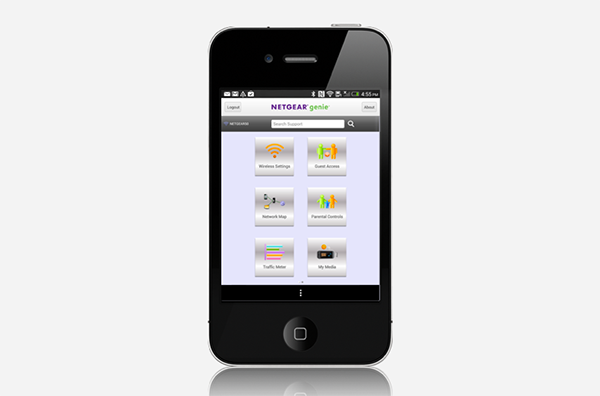
As is also the case with the R8000, Genie displays passwords as scrolling type. In other words, don't show it to strangers, or friends for that matter.
The R7000 can list and map its clients, and includes a nice Traffic Meter for monitoring what's coming and going. There's an easy-to-setup Quality of Service system, which prioritizes selected data packets or clients to get special treatment.
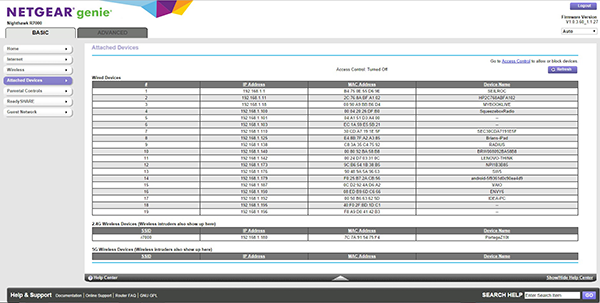
The R7000 is a step behind more-premium 802.11ac routers when it comes to extras. It lacks online storage, a virus scanner and the ability to use a 3G/4G USB dongle for emergency Internet access, putting it a step or two behind the $264 ASUS RT-AC87U. Happily, it can tap into DD-WRT open-source firmware written for the R7000, which can be used to tweak the router's performance or add features.
Performance
Powered by a 1GHz processor with 256MB of RAM and 128MB of storage space, the R7000 can work with three independent lanes of data flow. The dual-band router tops out at a theoretical 1.9 Gbps of bandwidth.
Based on tests with ixChariot software and unobstructed transmissions, the R7000 was able to move up to 444.8 Mbps of combined bandwidth at 5 feet. That's about 35 percent off what a tri-band router can do and slightly behind the 446 Mbps achieved by the dual-band Trendnet TEW-812DRU, which sells for about $120.
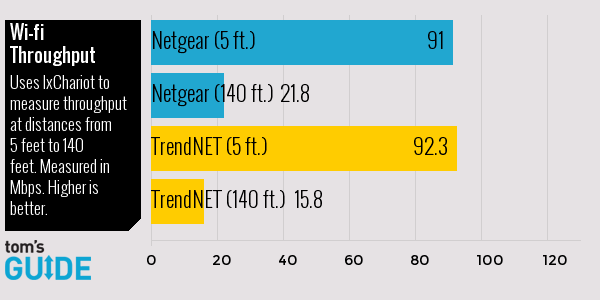
It's worth noting that while the R7000 hit its peak at about 5 feet from its clients, the 812DRU did so at closer to 15 feet.
In 5-GHz mode, the R7000's ability to move 353.8 Mbps of data at 5 feet was well above the average throughput of 315.2 Mbps and ahead of the $300 R8000's showing of 302.3 Mbps. The R700 was second best compared to the ASUS RT-AC68U's mark of 361.3 Mbps.
In the Tom's Guide test lab, the R7000 maintained a throughput of 252.4 Mbps from 140 feet, good enough to best the average (211 Mbps) and the TrendNet (209.5 Mbps), but still short of the ASUS AC68U (291.7 Mbps). However, in an older house with lots of walls, the R7000 lost contact with clients at 140 feet. That's 25 feet short of the class-leading R8000, but 5 feet longer than the DGL-5500. It's probably more than enough for an apartment or small house, but it won't fill your McMansion with data.
MORE: 10 Best Photo Storage and Sharing Websites
The router's 91 Mbps of 2.4-GHz bandwidth was good enough for a middle-of-the-pack result, trailing the TrendNet TEW-812DRU (92.3 Mbps), but well ahead of the RT-AC68U (74.9 Mbps).
I used the R7000 extensively for more than a week of heavy-duty data work, and it never balked when I performed our saturation test with four clients. I used the router to dole out a movie to an Android tablet, while serving up a TV show to a Windows slate and listening to an Internet radio program on an iPad — all while moving data back and forth with a desktop PC. Throughout, the Netgear was rock solid.
Warranty
Unlike the industry-leading Trendnet's three years of coverage and ASUS's two-year warranty, the R7000 comes with a scant 1 year of coverage.
Bottom Line
If you need a high-performance 802.11ac router for a fairly affordable price, look no further than Netgear's $190 R7000. While it lacks the reach for filling a larger home with data, it delivers solid speeds along with easy-to-use software. For around the same price, the ASUS RT-AC68U delivers even better throughput, but those who pick up the R7000 won't be disappointed.
Specs
Size: 2.0 x 11.2 x 7.3-inches
Number of Antennas/Removable: 3/Yes
Wi-Fi Spec: AC 1.9 dual-band 802.11ac
Ports: 4 gigabit Ethernet, USB 2.0 (back), USB 3.0 (front)
Peak 802.11ac performance: 444.8Mbps
Range in 2.4GHz mode: 140 feet
- 8 Biggest Tech Rip-Offs and How To Avoid Them
- Smartphone Interactive Buying Guide
- Tom's Guide Best Gift Ideas
Follow Tom's Guide at @tomsguide and on Facebook.
Brian Nadel is a freelance writer and editor who specializes in technology reporting and reviewing. He works out of the suburban New York City area and has covered topics from nuclear power plants and Wi-Fi routers to cars and tablets. The former editor-in-chief of Mobile Computing and Communications, Nadel is the recipient of the TransPacific Writing Award.
